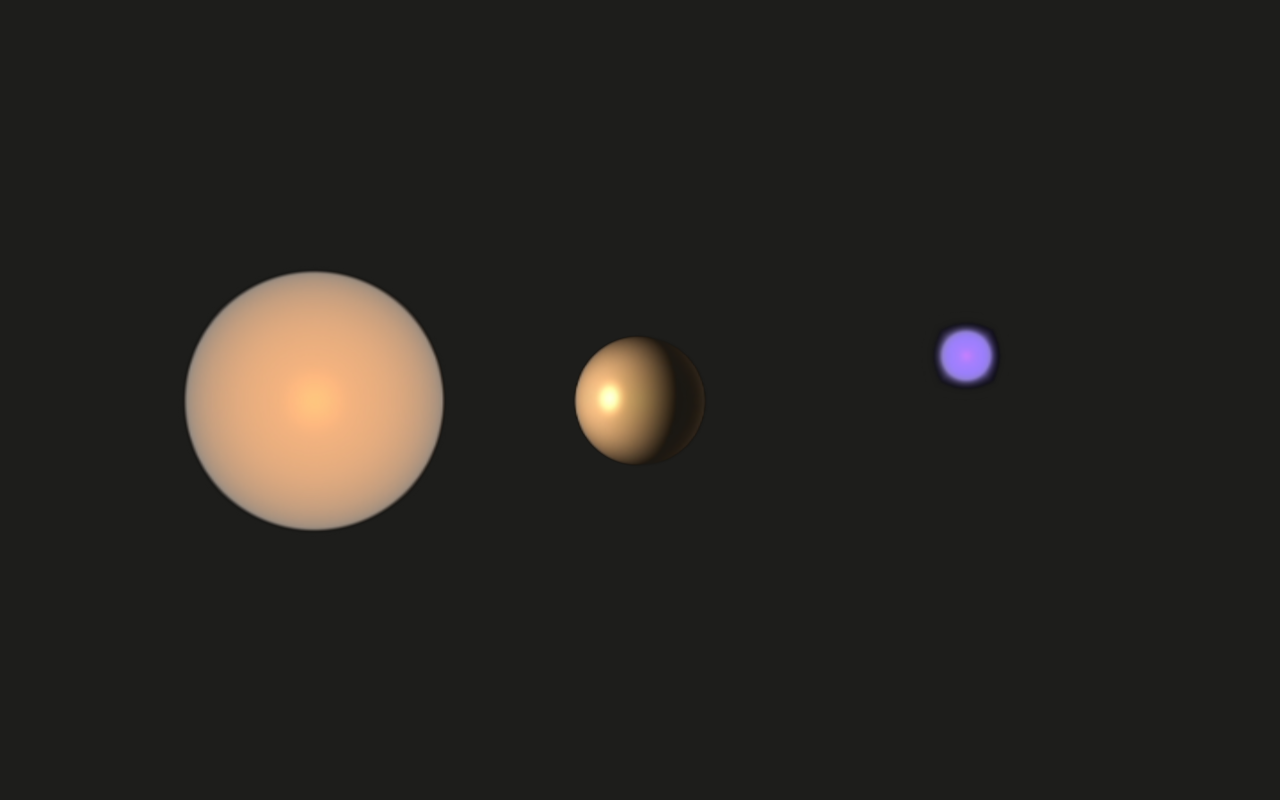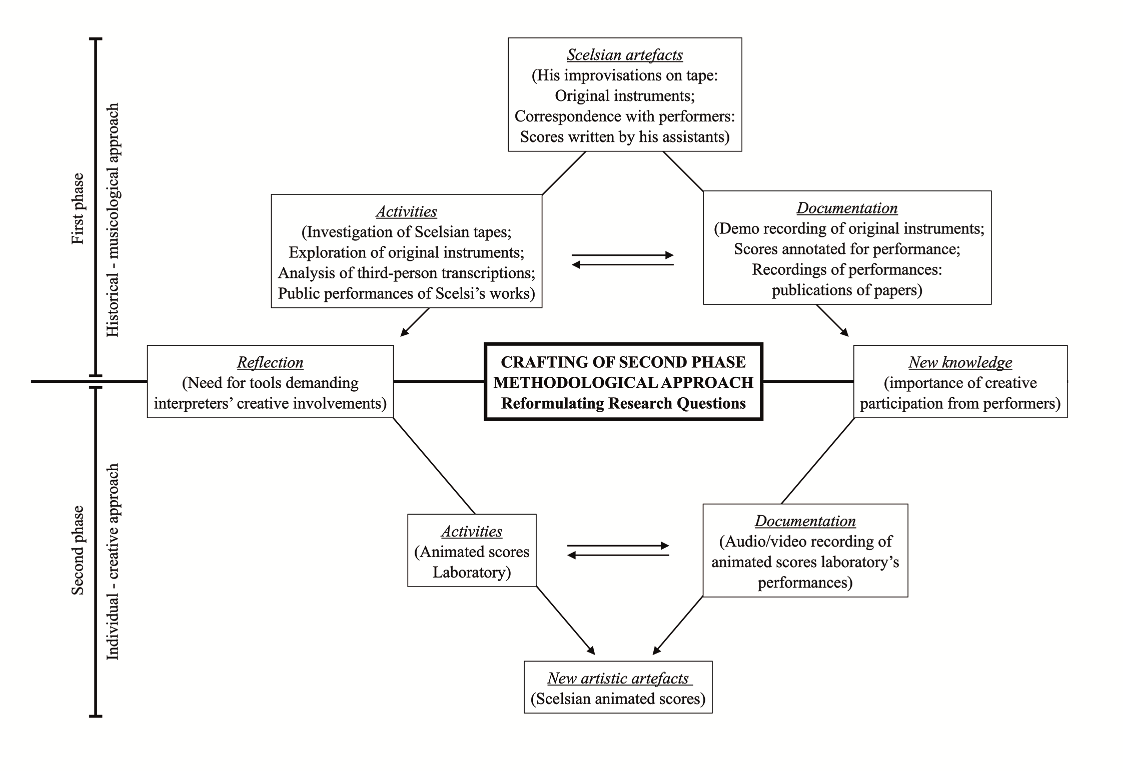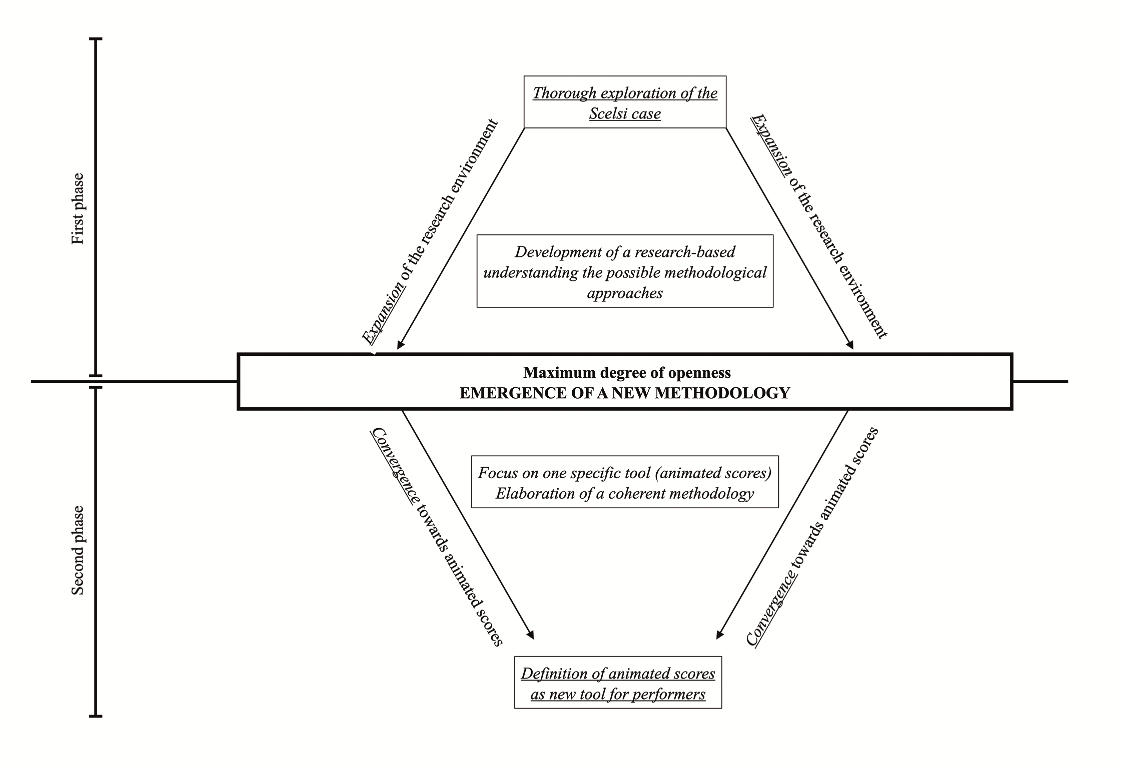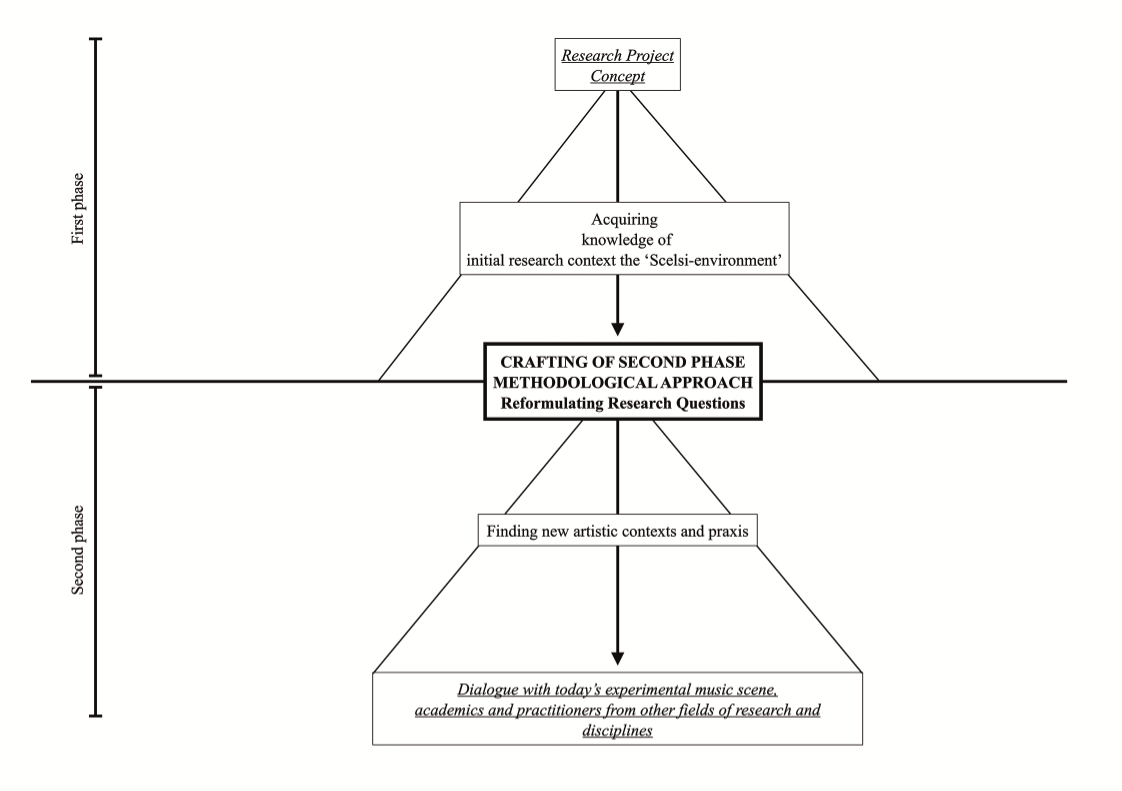This article was part of FORUM+ vol. 27 no. 3, pp. 54-60
Customizing a methodological approach. Researching Giacinto Scelsi’s performance practice through animated scores
Marco Fusi
Royal Conservatoire Antwerp & Conservatorio di Milano
This article presents the initial definition and subsequent adaptation of the research methodology adopted in Marco Fusi’s investigation of the creative process of the Italian composer and poet Giacinto Scelsi. The method adopted is purposefully designed with a decreasing degree of definition, to allow for the emergence of an efficient research strategy based on the early findings of the process. This organic approach has led to the definition of significant creative outcomes, useful for the development of the performance practice of Scelsi’s works.
Dit artikel zoomt in op het definiëren en vervolgens toepassen van de onderzoeksmethodologie die Marco Fusi aanwendde om het creatieve proces van de Italiaanse componist en dichter Giacinto Scelsi te bestuderen. De gebruikte methode is bewust zo ontwikkeld dat ze een toenemende scherpte vertoont, zodat er een efficiënte onderzoeksstrategie uit kan ontstaan, gebaseerd op de eerste bevindingen in het proces. Deze organische benadering heeft geleid tot het definiëren van belangrijke creatieve resultaten die van nut zijn voor de verdere ontwikkeling van de uitvoeringspraktijk van Scelsi’s werk.
Giacinto Scelsi (8 January 1905 – 9 August 1988) was an Italian composer and poet. His compositional method was based on extemporary creation through the practice of musical improvisation, carried out during states of consciousness altered by meditation. Scelsi believed his improvisations were inspired by superior deities, and often refused to be called a composer, arguing for his role to be that of a medium: in Scelsi’s words, ‘Je suis un intermédiaire seulement… Les choses arrivent au moment voulu, au moment où c’est nécessaire qu’elles soient entendues où pas. Tout est prévu là-haut, ça ne dépend pas d’ici’.1 His improvisatory sessions were recorded on tape, subsequently transcribed by his assistants, and the resulting written score was publicly diffused.
My interest in Scelsi arose when I discovered an unperformed work for violin and piano by Scelsi, Divertimento No. 1 in the Scelsi Archives and was granted the rights to premiere and record it. In order to develop a coherent and researched approach, my colleague pianist Anna D’Errico and I undertook a one-month residency as Visiting Researcher at the Orpheus Instituut in Ghent. This initial approach to the performance practice of Scelsi led to the world premiere2 and recording3 of Divertimento No. 1. It also showed me the potential for the undertaking of an in-depth research of the Scelsi-case. On the basis of this initial experience, with the aim of further investigating the questions that Scelsi’s creative process poses to performers, I applied for and started my PhD in the Arts at the University of Antwerp, Royal Conservatoire Antwerp in 2017, through the docARTES programme of the Orpheus Institute.
The most problematic aspect of Scelsi’s legacy is in its reliance on the score, written by his assistants in traditional European notation. During rehearsals, instead of requiring performers to comply with an ‘exact replica’ of the written text, Scelsi frequently challenged the imposing role of the written score. Scelsi demanded artistic participation from his interpreters, urging them to overlook the accurate reproduction of the score and to initiate the creative momentum of an original improvisation. According to Scelsian performer Frances-Marie Uitti, ‘In a way, when you are recreating it, you’ve got to give yourself the liberty to almost forget the score. It has to feel that free, you have to give the public the impression that it’s almost improvised music, that it’s happening, that it’s being created at that moment’.4
The juxtaposition of a well-defined methodology followed by a more flexible and mouldable research approach has proven to be a valuable resource for the development of a structured research.
As a classically trained violin and viola player, whose performative skills are measured by the faithfulness to the score and whose virtuosity is linked with the accuracy in the reproduction of the notated work, the Scelsi-case presents me with a challenging dilemma. Knowing that the score is not the ultimate and comprehensive representation of Scelsi’s works is disorienting. The artefacts of his compositional process do not seem to offer any univocal alternative reference point to orient my performances. The non-existence of a Scelsian urtext is a challenge to interpreters. Scelsi’s opus demands performers to reconsider their role and function within the creative process.
My research aims to investigate the creative process of Giacinto Scelsi, and to propose current and future Scelsian interpreters with a performance practice, informed by the knowledge of his creative habits, improvisatory skills, compositional routine, and collaboration with performers. My research questions identified the initial issue performers are faced with (‘traditionally, the written score has been trusted as the one and only possible vehicle to carry the original and definitive idea of a sonic phenomenon. Is this still the case with Scelsi’s works?’),5 and stated the need to investigate the available Scelsian documentation, to find interpretational insights and to develop an understanding of how to approach the performance of his works (‘How to understand and respect Scelsi’s original compositional idea when it is embedded in multiple, somewhat contrasting, original sources?’).6
My research methodology is divided into two phases: the first phase is concerned with an initial extensive scrutiny of the Scelsian artefacts; the second phase aims to generate new artistic tools, allowing for the implementation of the interpreters’ creativity in the act of performance. Considering the findings of the first phase could diverge the research into multiple directions, the methodology of the second phase is initially devised only in its overall direction, allowing for a postponement of its precise definition, guided by the outcomes of the first phase. The junction between the two phases is a crucial stage of the development of my research. This moment of openness and uncertainty is the necessary condition for allowing the emergence of a coherent methodological structure.
The methodological approach of the first phase aims to detail the Scelsian artefacts, exploring the available documents, recordings, musical instruments, and personal correspondence.
The steps of this initial phase are the following:
-
Analysis of tapes and scores
Investigation of the original audio material by Scelsi and comparison with the corresponding third-person transcribed scores.7 -
Investigation of musical instruments and recording equipment
- The original instruments used by Scelsi (Ondiola),8 currently in possession of the Fondazione Isabella Scelsi, are examined to have a clearer understanding of the technical intricacies that arise from their usage. An extensive audio and video sampling of the Ondiolas is collected.
- The recording devices used by Scelsi, called Revox, are subject of analysis, with a particular focus on their technical and creative possibilities.9
- Understanding the composer-performer collaboration
Investigation of Scelsi’s correspondence with his original performers.10

Figure 1: Schematic representation of first phase. Definition of Scelsi’s creative routine.
The methodology of the first phase examines the Scelsian artefacts through a series of exploratory activities with/ through these artefacts. This practical investigation is carried on in a constant dialogue with existing musicological and philosophical literature,11 in order to develop my active reflection on the activities undertaken, and to conceive new approaches for the exploration of the artefacts. The final result of the first phase is twofold: on the one hand, I develop a first-hand knowledge of these artefacts, through my empirical exploration; and on the other hand, my exploratory activities are presented to the public through an extensive and detailed process of documentation (disseminated through papers, lectures, and online material).12 This first phase represents an exhaustive empirical exploration of the research subject, starting from Scelsi’s available artefacts and leading to the definition of the environment Scelsi operated in (Fig. 1).
The findings of this first phase outline Scelsi’s complex relationship with the compositional process, and his disregards for the written score as the objectification of the composer’s will. Through empirical exploration of the Ondiolas, and the comparison with the Scelsian recorded improvisations, it is possible to infer the impact of the instrument and its technical possibilities over the Scelsian tapes, and to understand how Scelsi’s instinctual and instantaneous manipulation of the Ondiolas is an essential part of his creative approach. Moreover, through the exploration of the recorded tapes documenting Scelsi’s rehearsal sessions with interpreters, it appears that my definition of a Scelsian performance practice needs to reconsider the role and function of the performer, of whom he required and to whom he granted a wide creative contribution.

Figure 2: Example of an AS.
The subsequent second half of my research methodology emerges from these initial findings. Acknowledging the need for a creative participation of the performer, my research seeks to promote individual creative engagement through alternative ways of representing the Scelsian tapes. After an exploration of historical and contemporary musical notation techniques, such as scored improvisation, graphic scores, aural scoring, and deep listening, I have identified a specific kind of music notation, Animated Scores (AS),13 as the most applicable to my goal of fostering performers’ creative engagement (Fig. 2). I then reshape my research questions to investigate the use of AS as a tool for distributed creativity (‘How does the transcription of the Scelsian tapes in AS provide the player with a greater sense of creative freedom?’).14 Embracing my creative role within the research process as the designer of alternative ways of scoring the tapes, my new set of research questions include my acquired knowledge and experience with the Scelsian improvisations (‘How can specific instrumental, performing and improvising skills/experience contribute to an efficient design of AS?’),15 ultimately aiming to present my performance practice of Scelsi as a starting point for further confrontation on the role of performers in Western art music (‘How can the use of AS contribute to inquiring the current hierarchical composer-score-performer structure in classical music, and how does it challenge the distinction of roles between creator and reproducer?’)16 ,17
The detailed steps of this second phase are the following:
- Initial research
- Acquisition of materials: identification and acquisition of original tapes related to specific works from the Scelsian catalogue.
- Survey of current knowledge: examination of available documentation of AS. Collection and study of written literature on AS and visual representation of sounds.
- Technological possibilities: exploration of existing software for the realization of AS. Survey of applications for AS live-performance.
- Creation of the experimental environment
- Animated Scores Laboratory (ASLab): establishment of ASLab within the Royal Conservatoire Antwerp.18 The regular gatherings of ASLab provide an environment for experimentation and feedback.
- Experimental process
- Provisional definition of a transcription system: one initial system of visual transposition of the Scelsian tapes is defined.
- Creation and test of the first series of AS: the first series of AS is produced and performed by ASLab. Audio/video documentation and the ASLab sessions are analysed to detect problematics, implement modifications, and identify alternative strategies for representation.
- Improved versions: a series of successive versions, modified through documentation, examination, and feedback, are produced and tested during ASLab’s sessions.
- Collection of findings, presentation, and dissemination of outcomes
- A set of Scelsian AS is designated as support to performances of selected Scelsian works.
- The audio/video documentation of ASLab activities is made available online, through a dedicated page in the Research Catalogue.
- The premises of the research project, the documentation of the process, and the results achieved are collected and presented through written texts and interactive material.

Figure 3: Schematic representation of first and second phase.
Starting from the documentation and the experiential knowledge acquired through the first phase, I am able to design a series of activities to experiment with different sets of Scelsian-based AS. In order to facilitate the sharing of my findings, and to enhance the reflection and further development of the experiments, I assembled a cohort of artists, composers, and researchers with specific expertise in design and performance of AS.19 The outcomes of each experiment with the Scelsian AS are discussed with this team and their suggestions are instrumental to the further elaboration on the AS. Alongside the documental findings of the first phase, the definition of the Scelsian AS concludes my doctoral research, presenting a new series of Scelsian-based artefacts (Fig. 3).

Figure 4: Expansion and focus of the research field in the two phases.
The methodology of my research is a crucial guide for the advancement of the investigation. The identification of the two distinct phases allows for the development of specific research approaches. The first phase requires a historical and musicological investigation of the available Scelsian artefacts, demanding little creative involvement on my side. This phase can be represented as an expansion of my Scelsian knowledge, towards a comprehensive definition of the Scelsian case. Once an exhaustive investigation of the Scelsi-environment is completed, the need for further elaboration of my approach arises. At this pivotal point, the goals of my second phase become clearer, and my research method emerges and is defined in accordance. Scelsi’s demand for artistic participation requires the methodology to include and stimulate creative engagement of the researcher, as well as of all the subjects involved. Grounded in the documentation and knowledge emerging from the first phase, the research now focuses on notational systems not conceived by Scelsi, stimulating performers’ individual artistic experiences and instrumental approaches. The result of this approach appears to be much closer to Scelsi’s desired modus operandi than the traditional performance from printed scores (Fig. 4).

Figure 5: Schematic representation of the expansion of the research beyond the Scelsi-case.
The turning point of the research methodology is located at the junction between the first and second phase, where my research questions are reformulated, and the creativity of the researcher-performers becomes an essential part of the investigation. The first phase allows for an exhaustive exploration of the research context, whereas the second phase requires finding new contexts, outside of Scelsi’s practice, in order to individuate suitable alternatives to his traditional scoring system. This juxtaposition of a well-defined methodology followed by a more flexible and mouldable research approach has proven to be a valuable resource for the development of a structured research. It allows for the emergence of a coherent creative approach, established through a scrupulous investigation of the Scelsian existing evidences, in dialogue with today’s experimental music scene, academics, and practitioners from other fields of research and disciplines. By expanding the area of investigation beyond the Scelsi case, through this open and reconfigurable methodological approach, my research forms a connection with a broader community of musicians and benefits artists engaged in the field of music composition, interpretation, and improvisation (Fig. 5).
+++
Marco Fusi
is a violinist/violist and a passionate advocate for the music of our time. Active as a soloist and chamber musician on the international scene, Fusi is often invited to lecture at universities in Europe, United States, South America, and Australia. Fusi teaches Contemporary Chamber Music at the Milano conservatory ‘G. Verdi’ and is a doctoral researcher at the Royal Conservatoire Antwerp.
Footnotes
- Scelsi, Giacinto. Les Anges sont ailleurs…. Actes Sud, 2006, p. 69. ↩
- The world premiere of Scelsi’s Divertimento No. 1 took place at deSingel, Antwerp, on 17 January 2019 (Marco Fusi, violin and Anna D’Errico, piano). The concert was made possible by the support of the Royal Conservatoire Antwerp, the University of Antwerp, and the Italian Cultural Institute of Brussels. ↩
- The recording of Scelsi’s Divertimento No. 1 is published by the label Stradivarius (IT), as part of their Scelsi Collection - Vol. 7 (STR 33807), in collaboration with the Fondazione Isabella Scelsi of Rome. ↩
- Cellist Frances-Marie Uitti quoted in Colangelo, William. The composer-performer paradigm in Giacinto Scelsi’s solo works. Doctoral disseration, 1996, p. 55. ↩
- From research project application L’homme. Les sons. Faithful to what? submitted to Artesis Plantijn University College Antwerp in October 2017. Although performers often gather additional information on the works they perform to refine their interpretation, tapping into various kinds of available sources (such as biographies, performances & recordings, composer’s correspondence, etc.), the paramount role of the written score remains, for the vast majority of the classical and contemporary repertoire, unchallenged. ↩
- Ibid. ↩
- The digitalized version of Scelsi’s original recording are accessible at the Fondazione Isabella Scelsi in Rome. ↩
- ‘The Ondiola is an Italian rebranding of the Clavioline, a portable keyboard invented in 1947 by the French Constant Martin. The name and basic structure of the Ondiola recall the Ondioline, an instrument similar to the Clavioline, made in the same year by George Jenny, who developed this instrument from 1938.’ (Carboni, Fabio. ‘“Abitare il suono: Giacinto Scelsi e l’ondiola”. i suoni, le onde…’ n. 13, 2004, pp. 13-14). ↩
- For instance, the possibility of multitrack recording, as well as replay of the recorded material at different speeds (hence transposing the resulting pitches) or backwards (producing a retrogradation of the material). ↩
- I have been granted access to the archives of the late Prof. Devy Erlih, original performer of the majority of Scelsi’s works for solo violin, acquiring unpublished recordings and copies of annotated scores. ↩
- Such as Cook, Nicholas. Beyond the Score: Music as Performance. Oxford University Press, 2014 and Goehr, Lydia. The Imaginary Museum of Musical Works: An Essay in the Philosophy of Music. Oxford University Press (1992). Few performers have expressed their view on the role of the score, notably Kuijken, Barthold. The Notation Is Not the Music: Reflections on Early Music Practice and Performance. Indiana University Press, 2013 and Pace, Ian ‘Hierarchies in New Music: Composers, Performers, and “Works”’, ianpace.wordpress.com, last consulted 15 January 2019. ↩
- The terminology used to describe my methodological approach (Materials, Activities, Documentation, Reflection and New Knowledge) is borrowed from Hübner, Falk, ‘The Practitioner in the Centre. A flexible approach to methodology in practice-based research’. The Routledge Handbook for Practice-Based Research, edited by Craig Vear, Routledge, forthcoming. ↩
- Since the 1950s, various types of unconventional musical notations have been developed, in particular involving the use of graphic scores. Composers such as Cage, Cardew, Berberian, Feldman, and Stockhausen have afforded their performers more creative freedom, offering the opportunity to interpret graphic scores in more personal and creative fashions. Performers establish their own reading code, taking greater artistic responsibility for the final sonic result of the scores. A recent evolution of alternative notations is AS, a subcategory of graphic scores that relies on the use of dynamic video to convey a limited amount of performance information in real time, via the use of a screen. The employment of AS, according to Lindsay Vickery ‘enforces a replacement of reading with automatic physical reflex’, requiring reactivity and instant adaptation to external stimuli, an inherent feature of the mental state of musical improvisation. ↩
- From research project application Scelsi animated, submitted to Artesis Plantijn University College Antwerp in December 2019. ↩
- Ibid. ↩
- Ibid. ↩
- Audio recording of the performance of the AS pictured in the following image at Royal Conservatoire of Antwerp on 17 December 2019, is available at youtu.be/xmxOS-RwmYk. ↩
- ASLab is designed as a Research Practice Module and accessible to students of all levels. ↩
- Cat Hope (Monash University, Decibel Ensemble), Þráinn Hjálmarsson (SLATUR), Christopher Trapani (Butler School of Music at The University of Texas at Austin). ↩

